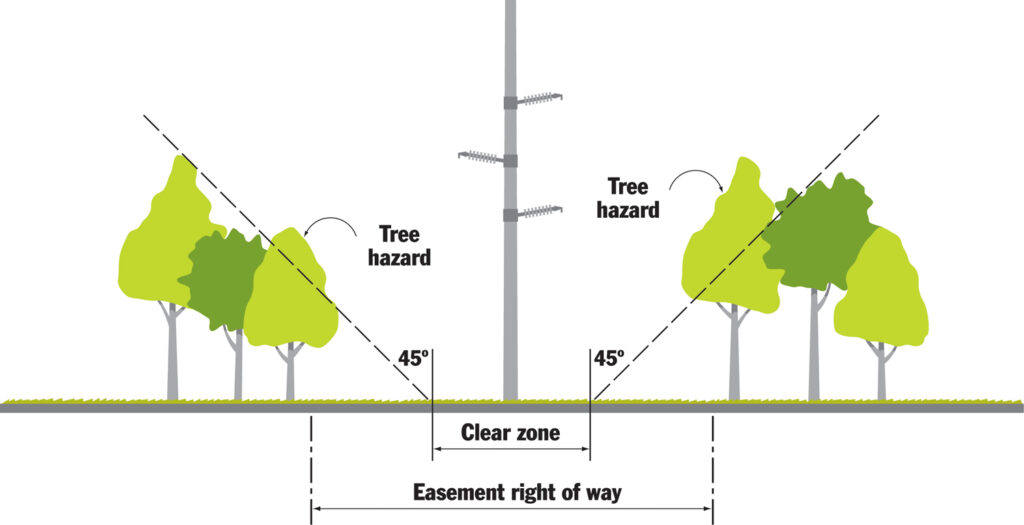After easements and necessary approvals have been secured, the power line can be built. Landowners will receive information about the construction process, which involves surveying, tree removal, construction and restoration of property.
During construction, we clean up along the route as best we can. Following construction, we restore the land as closely as possible to its original condition. Then a final cleanup and inspection are made.
Why do you have to remove or trim trees?
Our lines are built and maintained to meet industry standards, such as those defined by the National Electrical Safety Code and the North American Electric Reliability Corporation. For safety and reliability, a clear area along the power line route, or a clear zone, must be maintained at all times. (See diagram.) Transmission line wires are not insulated and produce heat as the electric current moves through the line. Trees that come too near a power line, or come in contact with a power line, can start on fire and/or cause a short circuit and outages. Additionally, line contact with trees or other objects that touch the ground can be dangerous for people nearby.

Do you have to remove even small trees?
Yes. Clearing crews will remove any trees or vegetation that would hinder the construction, operation or maintenance of the line and we remove tall-growing trees and saplings before they become a problem. Whenever possible, we leave shrubs and other low-growing vegetation in the edges of the right of way; however, an open area is needed on both sides of the transmission line’s center for accessibility.
Can I keep the wood?
As part of the easement, Great River Energy acquires the trees on the right of way; however, you can request the wood if the clearing method allows the wood to be saved.
What is involved in constructing the line?
You will be contacted about construction procedures and access to locations where poles will be located. If necessary, gates or openings at points of access will be installed. Concrete foundations for poles will be installed if necessary. Then the poles will be set and the wires installed.
Will you restore my property when you are done?
We always try to minimize the impact our projects have. During construction, we clean up along the route as best we can. Following construction, we restore the land as closely as possible to its original condition. Then a final cleanup and inspection are made. Restoration is part of our right of way management program which is designed to minimize the impact of transmission lines and ensure continuous operation.
How are crop losses determined?
Crop losses are determined by measuring the area damaged and multiplying it by the current market price per bushel and then using an average yield per acre for the type of crop. This calculation will be discussed with you at the time of settlement.
How large will the power poles be?
The transmission lines we build are most commonly 69-kV and 115-kV lines and are usually smaller than landowners expect. The large lattice towers that often come to mind are now rarely used for building new transmission lines, but sometimes are needed for lines operating at 345 kV and higher.
Can you bury the lines underground?
At first glance, it may seem that burying high voltage transmission lines underground is an easy solution. However, there actually are many drawbacks to burying transmission lines underground, for both property owners and utilities:
- They cost several times more than overhead lines due to the differences in equipment, materials and construction costs
- Repairs are much more difficult and expensive; outages can last days rather than hours
- The construction process is much more disruptive
- Land use is more restricted
- Large overhead structures are still needed in the locations where the line transitions from underground to overhead
Burying high voltage transmission lines is extremely disruptive to property. An open trench is required throughout the construction process.
Even though special areas (such as near airports or downtown areas) may require underground lines for short distances, transmission lines will continue to be built overhead until a more reliable and economical method of underground construction and maintenance is developed. Great River Energy does not build transmission lines underground.